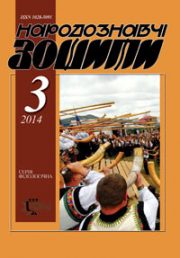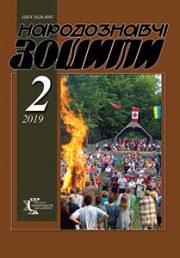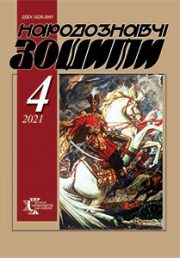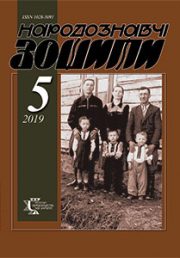2018 #5 Radovych R.
The Ethnology Notebooks, 2018, № 5 (143), 1191—1202
DOI https://doi.org/10.15407/nz2018.05.1191
Received 19.07.2018
ORCID ID https://orcid.org/0000-0002-1900-8948
Radovych Roman Bohdanovych, Candidate of Sciences in History, Ph.D, research fellow
in the Department of Historical Ethnology
of the Institute of Ethnology of the National Academy of Sciences of Ukraine.
Svobody Avenue 15, 79000, Lviv, Ukraine.
Contacts: Tel. (067)7117846; e-mail: ina@mail.lviv.ua
Abstrakt. Household buildings, intended for keeping livestock and poultry («staini», «karnyky», «kurnyky» etc.), as well as small architectural forms of a court yard (drying, wells) are considered. Their specific features and planning peculiarities are analyzed. Particular attention is focused on technique and technology of construction.
Keywords: Pokuttia, household buildings, «stainia», chicken coop, «karnyk», forehead, well, engineering technique.
REFERENCES
Arkhiv L‘vivs‘koho muzeiu narodnoi arkhitektury ta pobutu (dali — Arkhiv LMNAP). F. Materialy ekspedytsij. Spr. ZV-11. 45 ark. [in Ukrainian].
Arkhiv LMNAP. F. Materialy ekspedytsij. Cpr. Zv-15 (dodatok do ZV-17. T. I). 44 ark. [in Ukrainian].
Arkhiv LMNAP. F. Materialy ekspedytsij. Spr. ZV-16 (dodatok do ZV-17. T. II). 42 ark. [in Ukrainian].
Arkhiv LMNAP. F. Materialy ekspedytsij. Spr. ZV-17. 41 ark. [in Ukrainian].
Arkhiv LMNAP. F. Materialy ekspedytsij. Spr. Zv-53. 35 ark. [in Ukrainian].
Vovk, Khv. (1995). Etnohrafichni osoblyvosti ukrains’koho narodu. In Vovk, Khv. Studii z ukrains’koi etnohrafii ta antropolohii (pp. 39—218). Kyiv: Mystetstvo [in Ukrainian].
Hahenmejster, V. (1930). Nastinni rozpysy Kam’ianechchyny: Materialy do vyvchennia ukrains’koho selians’koho mystetstva. Kam’ianets’-Podil’s’kyj: Vydannia khudozhn’o-promyslovoi profshkoly [in Ukrainian].
Hontar, T.O. (1979). Narodne kharchuvannia ukraintsiv Karpat. Kyiv: Naukova dumka — 137 s. [in Ukrainian].
Kozholianko, H. (1979). Etnohrafiia Bukovyny (Vol. 1). Kyiv: Naukova dumka [in Ukrainian].
Kozholianko, H. (2000). Narodoznavstvo Bukovyny. Narodna arkhitektura: Navch. posibnyk. Chernivtsi: Ruta [in Ukrainian].
Kosmina, T.V. (1980). Sil’s’ke zhytlo Podillia (kinets’ XIX—XX st.): istoryko-etnohrafichne doslidzhennia. Kyiv: Naukova dumka [in Ukrainian].
Makarchuk, S.A. (2012). Istoryko-etnohrafichni rajony Ukrainy: navch. posibn. L’viv: LNU imeni Ivana Franka [in Ukrainian].
Mohytych, I.R. (1987). Hospodars’ki budivli. In Hoshko, Yu.H., Kischuk, T.P., Mohytych, I.R., & Fedaka, P.M. Narodna arkhitektura Ukrains’kykh Karpat XV—XX st. (pp. 82—88). Kyiv: Naukova dumka [in Ukrainian].
Pan’kiv, M., & Derkach, I. (1994). Sadyba na Pokutti (kinets’ XIX — pochatok XX st.). Ivano-Frankivs’k [in Ukrainian].
Radovych, R. (2012). Hospodars’ki budivli dvoru volynian II pol. XIX — I-i pol. XX st. (za materialamy rivnens’koi chastyny etnohrafichnoi Volyni). In Rychkov, P.A. (Ed.) Arkhitekturna spadschyna Volyni: Zbirnyk naukovykh prats’ (Issue 3, pp. 212—218). Rivne: PP DM [in Ukrainian].
Radovych, R. (2007). Deiaki spetsyfichni aspekty hospodars’kykh budivel’ podil’s’koho dvoru (za materialamy pivdnia Khmel’nychchyny). Ukrains’ka kul’tura: z novykh doslidzhen’ (pp. 606—620). L’viv [in Ukrainian].
Radovych, R. (2015). Narodna arkhitektura Starosambirschyny XIX — pershoi polovyny XX st. (zhytlovo-hospodars’kyj kompleks). Kyiv: Vydavets’ Oleh Filiuk
Rusov, M. (1915). Typy sil’s’kykh selysch v poludnevij chastyni Halychyny. In Zbirnyk pryrodnycho-tekhnichnoi sektsii Ukrains’koho Naukovoho Tovarystva v Kyivi (Kn. 3, pp. 77—221). Kyiv: Drukarnia Druhoi Drukars’koi Artily, Velyka Volodymyrs’ka 43 [in Ukrainian].
Kolberg, O. (1882). Pokucie: Obraz etnograficzny (Vol. 1). Krakuw: W drukarni uniwersytetu jagellosskiego [in Polish].
Mroczko, Fr. X. (1897). Њnatysszczyzna (Vol. 1). Lwuw: Z drukarni Wiadysiawa Јozisskiego [in Polish].







